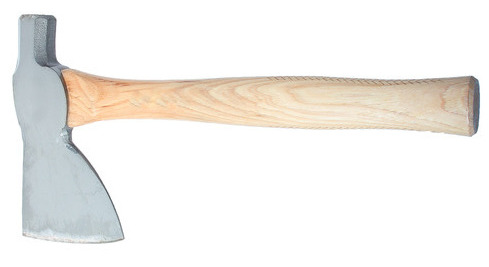The Florida Supreme Court overturned a Third District Court of Appeals decision on Thursday, reinstating a man’s big judgment. I don’t normally blog about negligence cases, but this one, which involves the negligence of a third party after a man was bludgeoned with a tomahawk is interesting.
The Facts
Three guys — Dennis Dorsey, Robert J. Reider, and Russell Noordhoek — were drinking in a bar one August night in 2007. All three were drunk. (Take a look at Noordhoek’s mugshot and arrest details from that night, and maybe you can guess where this story is going.)
Reider said he wanted to fight everyone.
Dorsey told him he was “acting like an asshole,” stood up, and walked out of the door.
Reider (who apparently was an asshole) and Noordhoek followed. Reider demanded to know why Dorsey had called him an “asshole.”
Dorsey kept walking. In the parking lot, he was between Reider’s pickup and a car.
Noordhoek followed Dorsey from behind, and Reider jolted around and blocked him from the front, the two men trapping him between the cars.
Reider continued asking why Dorsey had called him an “asshole.”
Several minutes later, Dorsey heard, from behind, the door to Reider’s truck open. He turned and saw Noordhoek reach into the truck and pull out a tomahawk. (Reider used it for work to help clear land.)
Dorsey turned back to Reider and asked, “What is this?”
Reider said nothing.
Dorsey tried to push Reider aside to escape. He and Reider grappled for about 15 seconds when Noordhoek struck Dorsey in the head with the tomahawk, knocking him out.
When Dorsey regained consciousness, Noordhoek and Reider were gone. Dorsey drove himself to the hospital. His injuries included a “severe laceration to his head, closed fracture of his nasal bones, and nerve damage causing long-term numbness in the back of his head and neck.”

The Lawsuit, Big Judgment, & Appeals
Dorsey sued Reider in Miami-Dade for negligence. A jury awarded him a damages award against Reider for $10,342 for past medical expenses, $40,855 for past lost wages, $669,600 for past pain and suffering, and $850,000 for future pain and suffering..
Reider appealed the case and won (for a little while at least). The Third District Court of Appeal found that Reider had no duty of care to Dorsey because it had no control over Noordhoek or any control over the tomahawk and was therefore not liable.
But then Dorsey asked the Florida Supreme Court to look at the case, and it did.
Analysis
The Florida Supreme Court had to figure out whether Reider had owed a duty of care to Dorsey. “[A] duty of care arises from four potential sources: (1) legislative enactments or administrative regulations; (2) judicial interpretations of such enactments or regulations; (3) other judicial precedent; and (4) a duty arising from the general facts of the case.”Dorsey v. Reider, SC12-2197, 2014 WL 1239898 (Fla. 2014) (citing McCain v. Fla. Power Corp., 593 So.2d 500, 503 n. 2 (citing Restatement (Second) of Torts § 285 (1965))).
When it comes to the fourth source – the facts of the case – the Court said it depends on “an evaluation and application of the concept of foreseeability of harm to the circumstances alleged.” Id. at 502–04. When a person’s conduct creates a “foreseeable zone of risk” posing a general threat of harm to others, a legal duty arises. Id. at 503.
Generally a party has no legal duty to prevent the misconduct of third persons. But there are exceptions, such as where “the defendant is in actual or constructive control of: (1) the instrumentality; (2) the premises on which the tort was committed; or (3) the tortfeasor.” The courts ask whether the defendant’s conduct created a foreseeable zone of risk.
In its analysis, the Court distinguished other cases, where no foreseeable risk (and thus no duty of care) had been found when mere access had been provided to the instrument that caused the injury. The cases included:
• Where a person had stolen keys from an unsecured area at a gymnasium, stolen a car, then gotten into an accident. In that case, “the foreseeable zone of risk created by the placement of a key board on a gymnasium wall does not include a motorist injured many miles and many hours away.” Michael & Phillip, 776 So.2d at 299;
• Where a gun owner was out of town when his wife found his gun and killed a guy. Mathis v. American Fire & Casualty Co., 505 So.2d 652 (Fla. 2d DCA 1987); and
• Where a gun was stolen from a store’s gun display case and used to kill someone. Keenan v. Oshman Sporting Goods, Co., 629 So.2d 210 (Fla. 5th DCA 1993).
This case was different, however, the Court said. It explained:
Reider did not “merely provide access” to the tomahawk, he blocked Dorsey’s escape and was present when the instrument was used to injure Dorsey. And, significantly, Reider was in a position to retake control of the tomahawk and prevent the injury—Dorsey testified that when Noordhoek took the tomahawk out of Reider’s truck, Dorsey asked Reider: “Bobby, what is this?” Dorsey testified that ten or fifteen seconds passed before he was struck. In that amount of time, Reider had the opportunity to see Noordhoek with the tomahawk before Noordhoek struck Reider. We conclude that the totality of the circumstances takes this case out of the “general rule” that one is not liable for injuries caused by a third party.
Reider left a dangerous tool in his unlocked truck, fully accessible to his friend Noordhoek, who obtained the tomahawk and injured Dorsey while Reider was present and blocking Dorsey’s escape. Not only did Reider have constructive control over the instrumentality, he had actual control over the area—that is, “the premises”—in which Dorsey was trapped and injured. . . .As we have explained, establishing the existence of a duty requires demonstrating that the activity foreseeably created a “broader ‘zone of risk’ that poses a general threat of harm to others.” Id. at 502. The facts of this case show that Reider’s actions created a broader zone of risk that posed a general threat of harm to others, i.e., Dorsey, who was between the two men and unable to escape. The minimal legal threshold to establish duty was therefore met. . . . We also conclude that this case meets the exception to the general rule that a duty of care does not extend to misconduct of third parties. Under the specific facts of this case, Reider’s duty of care extended to the misconduct of a third party, Noordhoek. . . .
The Florida Supreme Court remanded the case back to the trial court for reinstatement of the original trial court judgment.
As to whether Dorsey will be able to collect on that judgment, that’s another question.
The case is Dorsey v. Reider, SC12-2197, 2014 WL 1239898 (Fla. Mar. 27, 2014).




Leave a Reply